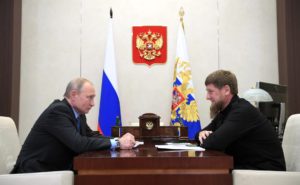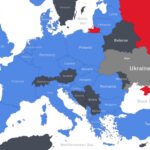
Russian President Vladimir Putin meeting in Novo-Ogaryovo with Head of the Chechen Republic Ramzan Kadyrov. June 15, 2018.
There are many perspectives on the Russian invasion of Ukraine and granted the West is not getting the full story from the Russian point of view. However, there have been no indications that Ukrainian forces anything other than courageous, or that they suffer from low morale. Why then would the Russians believe that trying to intimidate the Ukrainians with “scary” Chechnyan militia forces would work? Senior White House Correspondent Alexander Nazaryan reports for Yahoo! News:
Launched by Moscow in 1999, the second Chechen war elevated the stature of Russia’s new and then little-known prime minister, a former intelligence officer named Vladimir Putin. Intended to bring the mountainous Islamic region back under the Kremlin’s control, the exceptionally brutal campaign endeared Putin to Russians nostalgic for a show of strength from what was considered by much of the world to be a fading nuclear superpower.
“The bandits will be destroyed,” Putin said at the time, in an echo of how he would talk of the “Nazis” he now claims to be purging from Ukraine’s government and military. “We must go through the mountain caves and scatter and destroy all those who are armed.”
So when Chechen warlord Ramzan Kadyrov announced earlier this week that he was in Ukraine to support Putin’s invasion, it seemed as if the past had caught up with the present. Even though Kadyrov’s journey to the front — he claimed on social media to have nearly reached the capital, Kyiv, which is still under Ukrainian control — may have been fictitious, amounting to little more than a publicity stunt, some say his involvement could lead to an even bloodier conflict.
“Kadyrov is a psychopath who personally tortures his political prisoners,” Russia expert Michael Weiss told Yahoo News, alluding to Kadyrov’s well-known human rights abuses. Weiss and others say the apparent presence of Kadyrov’s soldiers in Ukraine could signal a new phase of fighting, one in which the rules of conventional warfare are discarded as Putin becomes more desperate for victory.
Kadyrov, 45, rules Chechnya under Putin’s supervision. And if Ukrainian President Volodymyr Zelensky is the conflict’s leading man, Kadyrov is the more colorful counterpart to chief villain Putin, given to brandishing a golden gun and trotting out a pet tiger. And even as he was supposedly preparing for war, Kadyrov engaged in a social media feud with Tesla founder Elon Musk.
His cartoonish demeanor, however, disguises a deep lust for power and a penchant for violence. Kadyrov commands a paramilitary outfit called the Kadyrovites, who work to suppress any rebellion in Chechnya, which has struggled to free itself from Russia (and other empires) for centuries. By doing Putin’s bidding — which has included hunting down opponents in Istanbul and Berlin — Kadyrov essentially guarantees he will retain the Kremlin’s support.
“The Russian military is facing a critical lack of manpower,” explains Emil Aslan, professor of security studies at Charles University in Prague. Kadyrovites, he told Yahoo News, “are an essential asset to the Russian military, both in tactical and psychological terms.”
White House press secretary Jen Psaki said on Thursday that the Biden administration could not confirm the presence of Chechen fighters in Ukraine. But such confirmation has come from battlefield reports, as well as from social media posts, where a kind of meta-battle is being waged for world opinion.
The Kremlin has not hyped Kadyrov’s role and, in fact, challenged the bombastic warlord’s own assertion that he was on the outskirts of Kyiv. At the same time, the Kremlin has few other allies to turn to.
“Russia’s scrounging for troops in Chechnya and beyond is probably a sign of how poorly the war has gone for them,” says Ben Friedman, policy director at the Washington, D.C., think tank Defense Priorities.
If you’re willing to fight for Main Street America, click here to sign up for the Richardcyoung.com free weekly email.





